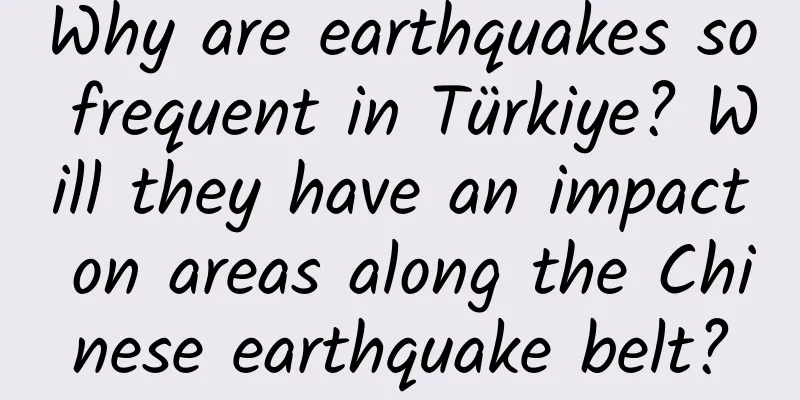Why are earthquakes so frequent in Türkiye? Will they have an impact on areas along the Chinese earthquake belt?

|
The Turkish earthquake was not caused by the bending and fracture of the strata, but by the mutual displacement of the fault zones within the strata. We need to wait until the earthquake energy ratio of the Eurasian seismic belt this year is determined before we can predict from experience whether it will affect China. Produced by | Science Popularization China Author | Earth's Gravity Producer | China Science Expo On February 6, 2023, two earthquakes with a magnitude of 7.5 or above occurred in Turkey and Syria in one day, shocking the world. As of February 8, the strong earthquake in Turkey has killed more than 7,700 people in Turkey and Syria, which once again drew people's attention to earthquakes. one How are earthquakes formed? Before discussing this issue, we need to understand a little bit about the theory of earthquake formation. Most earthquakes are caused by sudden movement of underground rock layers. We can imagine that the underground rock layers are like a bunch of chopsticks, which are being squeezed by some huge force (the source of this force will be discussed below). Normally, the chopsticks are constantly squeezed and therefore constantly bent. Common sense tells us that chopsticks have a limit to their bending, and so do rocks. When the force and bending exceed the limit, both chopsticks and rocks will break. You can try breaking a chopstick at home. Whether it is chopsticks or rocks, there will be a great vibration at the moment of breaking. The energy of this vibration is actually the energy stored when the chopsticks or rocks are bent. When they break, the energy is suddenly released, and the bent chopsticks or rocks return to their straight state. This is the elastic rebound theory in earthquake theory, which is also one of the widely accepted theories of earthquake formation. Schematic diagram of elastic rebound theory: 1 is the normal state, 2 is bending after being stressed, and 3 is the rebound of the rock layers on both sides to the normal state without stress after the fracture. Image source: wikipedia When this energy is transferred to the surface through the rock layers, it causes strong vibrations on the surface, which is the source of earthquakes. As we mentioned earlier, to bend a rock layer, it needs to be subjected to a huge force. Where does this force come from? From plate movement! Plate movement is actually driven by the heat in the Earth's inner core. As we all know, the Earth is divided into three parts: the core, the mantle, and the crust. After we greatly simplify this model (it is actually very complicated, and the simplification is just to help everyone understand), we can think of the core as a hot sphere with extremely high temperature (the temperature in some areas may reach 6000℃, which is equivalent to the surface of the sun), the mantle is in a plastic state similar to plasticine, and the crust is a hard thin shell. Under the heating of the core, the mantle will produce thermal convection - the heat density decreases and rises, and the heat that rises to the surface cools and sinks, and so on and so forth - the crust floating on the mantle moves under the convection of the mantle, which is the mechanism of plate movement. Of course, if you still don't understand, you can eat a hot pot, the stove is the core, the hot pot soup is the mantle, and the cabbage stalks are the crust. As long as the stove is on, the cabbage stalks in the hot pot will keep moving. Schematic diagram of the basic principle of plate movement: the core heats the mantle, and the mantle heat convection drives the movement of the crust floating on the mantle. Image source: concord.org CCBY-SA3.0 We now know that the Earth's crust is not actually a complete whole. It is actually made up of 14 large plates and several secondary plates. Driven by the heat of the Earth's core, they will collide with each other. Naturally, we intuitively know that the pressure is greatest where the plate boundaries collide, and this is consistent with what we have observed: at the plate boundaries, earthquakes and volcanoes occur most frequently. The most common type of plate boundary is the fault zone. The Earth's crust is not a whole, but is composed of 14 large plates and more secondary plates. Image source: pixabay, modified by the author two Why do earthquakes occur so frequently in Türkiye? With the above knowledge base, we can probably guess why Turkey has two major earthquakes in one day - it is located at the plate boundary. Specifically, Turkey is roughly located on the Anatolian Plate, and four plates wrap around it, so it is actually surrounded by four plate boundaries. Türkiye is located on the Anatolian Plate and is surrounded by four other plates. Image source: self-made by the author To its north is the huge Eurasian Plate, to its south is the African Plate, to its southeast is the Arabian Plate, and to its west is the Aegean Plate. Among them, the Arabian Plate in the southeast is very restless and is always squeezing the Anatolian Plate to the north. However, since the northern part of the Anatolian Plate is firmly held by the huge Eurasian Plate, it is difficult for it to move northward and can only slide westward. According to current tests, this plate is currently moving westward by about 2 cm per year. Schematic diagram of the westward movement of the Anatolian Plate under the compression of the Arabian Plate: the yellow line, pink line and black line in the figure are the boundaries of the plate, among which the yellow line is the North Anatolian Fault and the pink line is the East Anatolian Fault. Image source: wikipedia The movement of the Anatolian Plate has caused intensive earthquakes at its plate boundaries (which are basically large fault zones). In the past thousands of years, there have been many earthquakes here that were large enough to destroy cities. In the 120 years from 1900 to the present, there have been no less than 10 earthquakes of magnitude 7 or above in this area, and many earthquakes of magnitude 6 or above. Since 1900, earthquakes of all levels that have occurred near the Anatolian Plate can be seen to be basically consistent with the plate boundary. Image source: Wikipedia Specifically for this earthquake, since the earthquake just occurred, the relationship between these two major earthquakes is actually not clear. Some scientists regard it as a main shock and an aftershock, while some scientists regard it as two separate earthquakes. However, this does not affect our understanding of the principles of these two earthquakes - it is consistent with the chopstick example we mentioned above, but slightly different - The earthquake here is not caused by the bending and fracture of the strata, but by the mutual displacement of the fault zones within the strata. The fault zones in the strata at the plate boundary usually fit together like a puzzle, but under a huge driving force, the bite of the puzzle suddenly breaks, and the released force is completely released, and the strata may shift against each other for a long distance. The seismic intensity map of the first earthquake with a magnitude of 7.8 shows that the area with an intensity of 9 (IX) is basically along a straight line, which is the strike line of the fault. Image source: wikipedia Intensity map of a magnitude 7.5 earthquake. It can be seen that the trend of its maximum intensity is different from the first one. Image source: wikipedia Based on these two earthquakes and the smaller ones that followed, we can see that these earthquakes have obvious linear distribution characteristics, which are basically consistent with the fracture trend of the plate boundary. Image source: wikipedia According to the United States Geological Survey, the first earthquake with a magnitude of 7.8 may have ruptured 190 kilometers in length; according to the King Abdullah University of Science and Technology in Saudi Arabia, the rupture may have been more than 300 kilometers long. If we extrapolate this way, and consider that the earthquake depth is only 20 kilometers, then the destructive power of this earthquake may be comparable to that of the 2008 Wenchuan earthquake (the rupture length of the 2008 Wenchuan earthquake was more than 300 kilometers, and the focal depth was also less than 20 kilometers). In this earthquake, the distance between the southern city of Gaziantep and the epicenter is only about 20 kilometers, and there are about 2 million permanent residents here, so the losses are likely to be extremely huge. Gaziantep night view | Image source: wikipedia three Will the Turkish earthquake have a ripple effect on areas along the Chinese seismic belt? This is actually a very difficult question to answer. The main reason is that earthquakes originate underground and are caused by the rupture of rock strata. We cannot see through the rock strata to understand the rock properties, structures, and constructions at different depths underground as well as the stress states they are subjected to. Therefore, our current earthquake prediction work is very weak, and we are naturally unable to make advance forecasts like weather forecasts, or to judge the future impact range of certain extreme weather conditions. However, despite this, there are still many seismologists studying these contents. One of the methods is to use regular statistical methods. Some scientists have counted the impact of the increase in seismic activity in the Eurasian seismic belt on earthquakes of magnitude 7 or above in mainland China. The results show that if the energy released by earthquakes in the Eurasian seismic belt exceeds 50% of the global earthquake energy released throughout the year, there is a greater possibility of an earthquake of magnitude 7 or above in mainland China within the next three years; if the earthquake energy ratio in the Eurasian seismic belt exceeds 50%, and there has been an earthquake of magnitude 8 in the Eurasian seismic belt, then China may experience multiple earthquakes of magnitude 7 or above, or even magnitude 8, within three years. This result has been tested for significance, with a significance level of 10%, which means that the correct probability is 90%.
The energy ratio of the Eurasian seismic belt changes over time. It can be seen that before 2008, the energy ratio was about 90%. Image source: Chen Xuezhong, Li Yan'e, Wang Hengxin. Analysis of the relationship between the increase in seismic activity in the Eurasian seismic belt and the occurrence of earthquakes above magnitude 7 in mainland China [J]. Earthquake, 2020, 34(1): 34-40. However, we still need to see that this is just an empirical statistic. We are still lacking in many aspects of plate movement research, such as the degree of mutual influence between plate movements, the way energy is transmitted after collision, etc. These are the factors that determine how much stress a place will have and whether a major earthquake will occur. Therefore, from this paper, we need to determine the earthquake energy ratio of the Eurasian seismic belt this year in order to predict from an empirical perspective whether it will affect China. In the long run, we need to know more about the deep underground before we can predict earthquakes and a series of impacts after earthquakes. Produced by: Science Popularization China Editor: Sun Chenyu Special Tips 1. Go to the "Featured Column" at the bottom of the menu of the "Fanpu" WeChat public account to read a series of popular science articles on different topics. 2. Fanpu provides a function to search articles by month. Follow the official account and reply with the four-digit year + month, such as "1903", to get the article index for March 2019, and so on. |
<<: In 2023, these rockets will be on a mission, come and take a look!
Recommend
Robin Li reveals Baidu Brain AI will become the new era of electricity
In 2016, as the dividends from mobile Internet fa...
iPhone after-sales adjustment: Apple finally compromises
Apple is promoting safer and more compliant iPhon...
German quality, reciprocating double blade heads, Xiaomi Braun electric shaver redefines men's charm
Someone once said that Mijia's products never...
Chen Weixian: The third phase of the private domain business operator training program is worth 2998 yuan
The course comes from the third phase of the Priv...
The leader of their migration is actually an airplane?
Right now, an incredible feat is taking place in ...
Top 10 highlights of world aerospace in 2022
2021 was an extraordinary year in human space his...
When is Eid al-Adha in 2022? What specific month and date are the holidays? Attached is the latest official holiday arrangements!
Eid al-Adha is an important festival for my count...
Apple's new review rules: Apps that mention other mobile platform names in apps or metadata will be rejected
1) According to Gamasutra, Apple's developer ...
What's the next step for smart home? Convincing consumers is the key
Do you use Nest to control your oven? Is your car...
Price inquiry for the production of Panzhihua fast food mini program. How much does it cost to produce Panzhihua fast food mini program?
In order to better penetrate into various industr...
New media advanced operation growth practical training
Introduction to practical training resources for ...
Momo information flow advertising types and promotion effects!
When we open the Momo app, we can see some advert...
The Spring and Autumn Period and the Warring States Period of Mobile Operating Systems
Nowadays, when we talk about smart mobile termina...
Is there really a mysterious force in space? Astronauts encounter "weird hallucinations" in space
If an ordinary person says that he or she has see...









